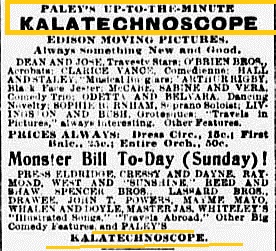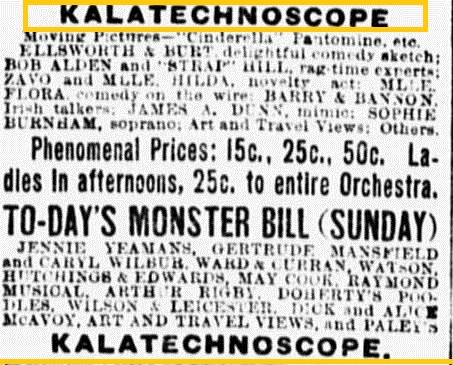Kalatechnoscope
early motion-picture projector / 1900s
![]()

William C. Paley




![]()





Born in England, Paley emigrated to the United States where he became an X-Ray exhibitor until his health started to suffer from the effects of the machine.
Abandoning X-rays, in 1897 he built a film projector which he named the Kalatechnoscope, and was soon taken on as a cameraman by the Eden Musée, partly
to film a version of the Passion Play staged on a New York rooftop.
War was brewing with Spain at this time, and in 1898 Paley contracted with the Edison company to film it. Paley was soon known among the war correspondents as
'the Kinetoscope Man', distinctive both for his own size and for the novel camera he carried. But he found that filming warfare was not easy, it was a war of
hidden snipers and Paley sadly concluded, 'I don't think there is much in this campaign for the kinetoscope'. Then his camera malfunctioned, and living out in
the open he went down with fever, almost dying coming back to America.
Following recovery he returned to camerawork, and the following year [1899] established a long term arrangement with the showman F.F. Proctor, over the next few years
filming as an Edison licensee. By mid 1904 Paley had formed a partnership with William F. Steiner, and they began releasing short comedies. But by now the Edison
company began cracking down on independents, and in November they sued several companies including Paley-Steiner, and by 1905 the partnership was dissolved.
This was not the end of Paley's woes: in late 1906 or early '07 he was forced out of business as an independent producer and was looking for work as a freelance
cameraman. He next surfaced in 1910, shooting westerns at the Star Film Ranch in San Antonio, Texas.
The following year the company moved to California, and it is likely that Paley spent much of the rest of his life in the West. In March 1912, employed by the
Nestor Company to film the California mountains he suffered a fall, and one leg had to be amputated. Almost destitute, his colleagues started a fund to help him
during his final years.


The kalatechnoscope was soon at Proctor's house in Albany, New York, as well, and once the vaudeville impresario took over the Fifth Avenue Theater in May 1900 and the
125th Street Theater in August, Paley had his service in five Proctor houses on a full-time basis. The opening of Proctor's Montreal theater in March 1901 provided Paley
with a sixth permanent outlet. Although Paley exhibited in other venues, these contracts were of brief duration; Proctor was to remain his key customer in the years ahead.
The general popularity of moving pictures at this time is underscored by Paley-related evidence. A photograph of Proctor's Twenty-third Street Theater in 1900 shows that
from Imaginary Interviews by William Dean Howells)
"Why, bless my soul!" the rejected one cried, starting somewhat violently forward, "what is your magazine itself but vaudeville, with your contributors all doing their stunts
"There were twelve stunts on the bill, not counting the kalatechnoscope, and I got in before the first was over, so that I had the immediate advantage of seeing a gifted
"But I had had enough without counting him, though I left the kalatechnoscope, with its shivering and shimmering unseen. I had had my fill of pleasure, rich and pure,
NOTE: I searched all the reference materials I could and the earliest mention I could find of the Kalatechnoscope was 1897.
over the marquee there was a sign in bright lights announcing "Moving Pictures." The kalatechnoscope was also given a prominate role in Charles Frohman's theatrical production,
Hearts Are Trumps, which opened at New York's Garden Theater on 21 February 1900. According to Cecil Raleigh's script, a music-hall girl lures a lecherous, evil earl to
a studio and has him surreptitiously filmed as they do a dance. Later, as the nobleman's perfidious nature is revealed, he is humiliated -- and the music hall is saved from
bankruptcy -- when the films are shown to delighted crowds. For the play's story to be believable, film exhibitions had to be seen as having drawing power, particularly when
of fiction, or poetry, or travel, or sketches of life, or articles of popular science and sociological interest, and I don't know what all! What are your illustrations but the
moving pictures of the kalatechnoscope!"
fellow-creature lightly swinging himself between two chairs which had their outer legs balanced on the tops of caraffes full of water, and making no more of the feat than if it
were a walk in the Park or down Fifth Avenue."
such as I could have got at no legitimate theatre in town, and I came away opulently content." We reflected awhile before we remarked: "Then I don't see what you have to complain
of or to write of."

As you can see from the clippings, it showed up regularly in the newspapers from 1899 until 1901, when it suddenly disappeared.
The last reference I found for it was in a 1904 Newark, NJ program from a Proctor's theatre - where it might have been a hand-me-down
from one of Proctor's New York City theatres..
Newspaper Clippings
New York Times / April 5, 1897 (pg.6)

New York Times / April 9, 1897 (pg.6)

New York Tribune / October 9, 1899 (pg.8)

New York Sun / October 10, 1899 (pg.8)

New York Sun /October 15, 1899 (pg.12)

New York Sun / November 5, 1899 (pg.12)

New York Tribune / November 12, 1899 (pg.10)

New York Tribune / November 19, 1899 (pg.8)

New York Tribune / November 26, 1899 (pg.12)

New York Sun / December 10, 1899 (pg.10)

New York Sun / December 24, 1899 (pg.12)

New York Tribune / January 7, 1900 (pg.10)

New York Tribune / January 21, 1900 (pg.8)

New York Tribune / January 28, 1900 (pg.8)

New York Tribune / February 4, 1900 (pg.8)

New York Tribune / February 18, 1900 (pg.3)

New York Tribune / February 20, 1900 (pg.6)

New York Tribune / February 25, 1900 (pg.8)

New York Tribune / February 27, 1900 (pg.10)

New York Tribune / March 4, 1900 (pg.8)

New York Tribune / March 14, 1900 (pg.12)

New York Tribune / April 8, 1900 (pg.8)

New York Tribune / April 15, 1900 (pg.8)

New York Tribune / May 13, 1900 (pg.14)

New York Tribune / May 15, 1900 (pg.6)

New York Tribune / May 29, 1900 (pg.6)

New York Tribune / June 10, 1900 (pg.12)

New York Tribune / June 12, 1900 (pg.6)

New York Tribune / June 17, 1900 (pg.12)

New York Tribune / June 24, 1900 (pg.12)

New York Tribune / September 4, 1900 (pg.14)

Asbury Park (NJ) Daily News / September 7, 1900 (pg.4)

New York Tribune / September 9, 1900 (pg.1/Sun.sec.)

New York Tribune / September 23, 1900 (pg.14)

New York Tribune / October 2, 1900 (pg.9)

New York Tribune / October 7, 1900 (pg.16)

New York Tribune / October 9, 1900 (pg.14)

New York Tribune / July 28, 1901 (pg.8)

New York Tribune / August 11, 1901 (pg.26)

Brooklyn Life / August 31, 1901 (pg.25)

Programs:
1904 Proctor's Newark Theatre Vaudeville program